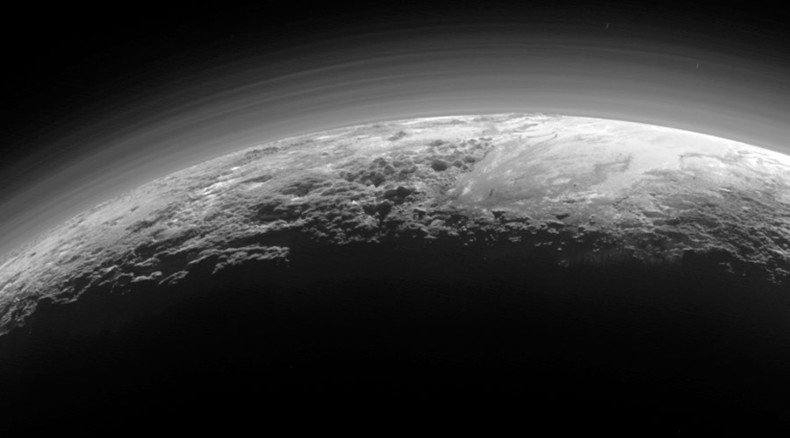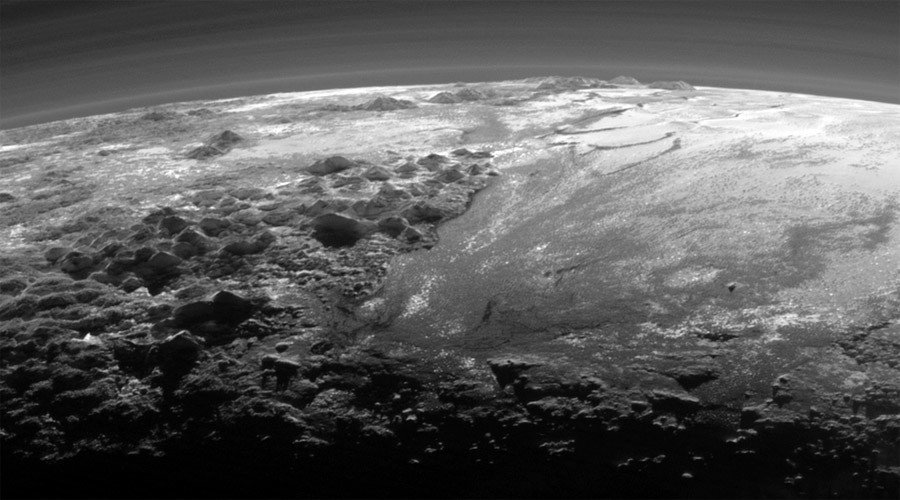‘Scientific bonanza’: New NASA images reveal Pluto’s giant ice mountains, hazy world

The latest images from Pluto taken by NASA’s New Horizons spacecraft show amazing new details about the dwarf planet’s atmosphere, weather patterns and streams of frozen nitrogen. NASA is calling it “a scientific bonanza.”
A stunning panoramic image of Pluto’s crescent, backlit by the Sun shining through the world’s hazy atmosphere, was taken just two months ago by NASA’s New Horizon spacecraft,and downloaded to Earth on September 13. It is the first spacecraft to fly by Pluto and record images of the intriguing icy dwarf planet.
“This image really makes you feel you are there, at Pluto, surveying the landscape for yourself,” said Alan Stern of the Southwest Research Institute in Boulder, Colorado, and a principal investigator for New Horizons, in a NASA statement.
“But this image is also a scientific bonanza, revealing new details about Pluto’s atmosphere, mountains, glaciers and plains.”
Amazing new images of Pluto from New Horizons shows networks of nitrogen rivers https://t.co/uD2geczGsGpic.twitter.com/VtSzqAGBEr
— Dannie Gregoire (@dgregoire) September 10, 2015NASA scientists knew Pluto’s nitrogen atmosphere extended from the planet’s surface. With the benefit of backlighting and high resolution images, they can detect more than a dozen thin haze layers extending from near the ground to at least 60 miles (100 kilometers) above the surface.
“In addition to being visually stunning, these low-lying hazes hint at the weather changing from day-to-day on Pluto, just like it does on Earth,” said Will Grundy from the Lowell Observatory in Flagstaff, Arizona, and the lead of the New Horizons Composition team.
Driven by dim sunlight, this would be directly comparable to the hydrological cycle that feeds ice caps on Earth, where water is evaporated from the oceans, falls as snow, and returns to the seas through glacial flow.”

Scientists say the recent images provide evidence for an Earth-like “hydrological” cycle – more commonly known as the water cycle – on Pluto. But unlike on our watery Earth, this cycle involves haze or fog and “exotic ices” made of nitrogen and methane.
One noted feature on Pluto is its icy plain, Sputnik Planum, a smooth upland region that is flanked by rugged mountains up to 11,000 feet high. The new images show to the east of Sputnik might feature glaciers that are probably composed of frozen nitrogen, with clues suggesting that the ices might have evaporated from the plain.
Scientists say the features are similar to frozen streams on the margins of ice caps on Greenland and Antarctica.
"We did not expect to find hints of a nitrogen-based glacial cycle on Pluto operating in the frigid conditions of the outer solar system,” said Alan Howard, a member of the mission’s Geology, Geophysics and Imaging team from the University of Virginia, Charlottesville, in the statement.
“Driven by dim sunlight, this would be directly comparable to the hydrological cycle that feeds ice caps on Earth, where water is evaporated from the oceans, falls as snow, and returns to the seas through glacial flow.”
New Horizons transmits 'head-scratching' new Pluto pictures
http://t.co/PcxbHM5oI1pic.twitter.com/ye3Eywaxpt
— RT America (@RT_America) September 11, 2015Pluto is the tenth massive object to orbit the sun in our solar system and has five moons. It is about 18 percent the size of Earth, over 1,400 miles (2,370 kilometers) in diameter.
“Pluto is surprisingly Earth-like in this regard,” said Stern about its valley glaciers and hydro-like cycle, “and no one predicted it.”












